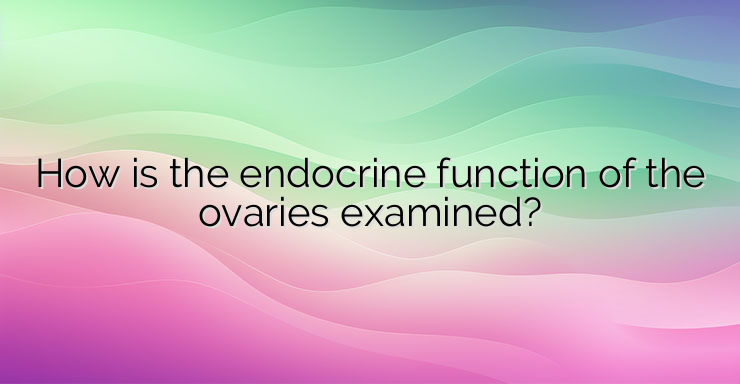The ovaries are the female gonads located in the fossa ovarica of the pelvis. Their main function is related to the production of the female sex hormones – estrogens and progesterone, and the release of an egg ripe for fertilization in a process called ovulation. The hypothalamus-pituitary-ovary axis is of primary importance for the control of a woman’s reproductive function. The hypothalamus produces gonadotropin-releasing hormone (GNRH), which stimulates the secretion of follicle-stimulating (FSH) and luteinizing (LH) hormones from the anterior pituitary. In turn, the hormones secreted by the pituitary gland are important for the production of estrogens and progesterone and for the process of ovulation. Disruption at any level of the hypothalamus-pituitary-ovary axis leads to disturbances in a woman’s reproductive capabilities. In addition to the mentioned hormones, prolactin and other steroid hormones such as testosterone, free testosterone, dehydrotestosterone (DHT), sex hormone-binding globulin (SHBG), 17-hydroxyprogesterone, dehydroepiandrosterone-sulfate (DHEA-S), androstenedione are important for ovarian function. cortisol and free cortisol. The examination of FSH, LH, prolactin and estradiol is carried out in the early follicular phase of the menstrual cycle, that is, from the 3rd to the 7th day of menstruation. The normal level of follicle-stimulating hormone during this phase is 5-15 UI/l, and of estradiol (E2) – 110-330 pmol/l. There is a ratio between the level of FSH and LH which is normally 1:1 or 1.5:1. At higher levels of luteinizing hormone, where the LH:FSH ratio becomes 2:1 or 3:1, there is a possibility of ovarian hyperandrogenemia, which is particularly characteristic of polycystic ovary syndrome (PCOS). Low levels of estradiol, in the background of high values of FSH and LH during the early follicular phase, are found in hypoovarianism, while extremely high values of estradiol during this phase are a sign of the presence of a hormone-producing tumor of the ovary. Normal prolactin values during the early follicular phase are between 320 and 480 UI/l, but in some cases values up to 800 UI/l are considered physiological or suspiciously pathological. Prolactin values above 800 UI/l indicate hyperprolactinemic hypogonadism, the main cause of which is a pituitary adenoma – prolactinoma. Estradiol, follicle-stimulating and luteinizing hormones can also be tested during the ovulatory phase of the monthly cycle – the 14th day. Their low values during this phase indicate the presence of anovulatory cycles. Progesterone, on the other hand, is usually tested during the luteal phase of the monthly cycle, from the 20th to the 24th day. Its low values during this period are a sign of anovulation. Ovarian hyperandrogenemia is a condition in which increased production of androgens is observed, which is clinically manifested by dysmenorrhea, amenorrhea, anovulatory cycles, acne, hirsutism, obesity, alopecia, etc.Ovarian hyperandrogenemia is diagnosed by testing testosterone, free testosterone, DHT, and SHBG during the early follicular phase. Upper limit or slightly elevated values of testosterone, free testosterone and DHT and decreased levels of SHBG confirm the diagnosis. Very high testosterone levels may be due to androgen-producing tumors. Because hyperandrogenemia can be of ovarian or adrenal origin, the steroid hormones 17-hydroxyprogesterone, DHEA-S, and cortisol are also investigated. There are also dynamic tests that reflect ovarian reserve and serve to differentiate between primary and secondary (pituitary) hypoovarianism. These tests include the progesterone test, the estrogen-progesterone test, the Bromoergocriptine test, and the Clomiphene Citrate test. In the progesterone test, the patient is injected with intramuscular progesterone for five consecutive days, after which bleeding is expected for up to 7 days. A negative test proves primary hypoovarianism. The clomiphene citrate test is used to diagnose anovular cycles, while the bromoergocriptine test is used to diagnose hypoovarianism due to pathologically high prolactin levels. The estrogen-progesterone test is performed in case of a negative progesterone test. He is injected with a synthetic form of estradiol for three days, followed by a five-day course of progesterone, after which bleeding is expected for up to 7 days. A negative test occurs in Turner’s syndrome with uterine aplasia, in Asherman’s syndrome, in Rokitansky’s syndrome. There are also dynamic tests with gonadotropic hormones and with gonatropin-releasing and thyrotropin-releasing hormones, the purpose of which is the differential diagnosis between primary, secondary (pituitary) and tertiary (hypothalamic) hypoovarianism.He is injected with a synthetic form of estradiol for three days, followed by a five-day course of progesterone, after which bleeding is expected for up to 7 days. A negative test occurs in Turner’s syndrome with uterine aplasia, in Asherman’s syndrome, in Rokitansky’s syndrome. There are also dynamic tests with gonadotropic hormones and with gonatropin-releasing and thyrotropin-releasing hormones, the purpose of which is the differential diagnosis between primary, secondary (pituitary) and tertiary (hypothalamic) hypoovarianism.He is injected with a synthetic form of estradiol for three days, followed by a five-day course of progesterone, after which bleeding is expected for up to 7 days. A negative test occurs in Turner’s syndrome with uterine aplasia, in Asherman’s syndrome, in Rokitansky’s syndrome. There are also dynamic tests with gonadotropic hormones and with gonatropin-releasing and thyrotropin-releasing hormones, the purpose of which is the differential diagnosis between primary, secondary (pituitary) and tertiary (hypothalamic) hypoovarianism.


Leave a Reply